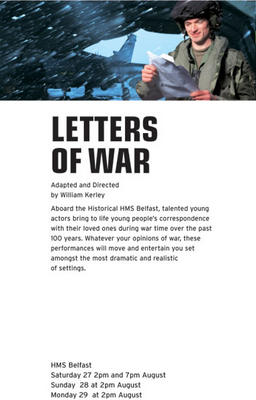RECENT PRODUCTION: LETTERS OF WAR - National Youth Theatre

DIRECTOR'S PROGRAMME NOTE
HMS Belfast is a living part of the Imperial War Museum. Her raison d’etre is war. Not a cruise ship, but a warship. The kitchens, the mess rooms, the post room, the high slung hammocks - all exist for one purpose: to support the sailors who manned Belfast’s monstrous guns.
What better place for the National Youth Theatre to present a play inspired by combatants’ corresponence, by LETTERS OF WAR?
On my first visit to the ship, I arrived at the same time as an excited group of schoolboys. For a previous generation these young souls would be cannon fodder. In the hospital wing, looking at a reconstruction of bloody surgery on the ship’s operating table, a kindly tourist who stood next to me said the sight was ‘a bit too realistic’. The truth is that the reality of war is unimaginable for the lucky ones, like us, whose experience of war has been indirect, with conflicts far from home; or far away enough to ignore.
But that’s why this ship has been saved for the nation. To enable us to see a little of the existence of the seamen who gave their lives for the freedoms we now so easily take for granted; not least of which is the freedom to make artistic statements, to write, to create art, to make plays.
The process of devising an original piece of drama is a tough, but a simple one. Without a playwright, theatre-makers must harness their creative appetites, and get fed. First part of the recipe: collect as much material as you can, next: choose the bits you like best, finally: shape them into a performance.
The National Youth Theatre season for 2005 is entitled Young at War. There isn’t a single family in this country which hasn’t been touched by war, somehow. Before rehearsals began, I asked the actors to get nosey, to ask awkward questions of elderly relatives, to rummage in attics for wartime correspondence; to bring their own source material to the project.
You are about to see the result of our labours.
But, remember that the best theatre is made for a context, a place. And even military men appropriate the language of the artist - for an Admiral or a General, a battlefield is a Theatre of War.
And remember that on this ship you are surrounded by the brave departed. Among their ranks are the ghosts of Scharnhorst (the German ship hunted and destroyed by HMS Belfast in Danish waters in1943 - there were only 36 survivors from a crew of 1,963 men). Remember the sad ghost of a Olga the Reindeer - a mascot given as a present by the Soviet navy in 1944 - driven mad with fear at the sound of Belfast’s six-inch guns, she had to have her brains blown out after a couple of days on board.
All around you are the spirits of the sailors who made this place their home, their workplace, their refuge, their weapon of war. Where’s the best place to tell a story about the universal themes of combatants longing for their loved ones, hoping for an end to the fighting? Here, on board a ship which brings the realities of war into sharp dramatic focus.
Belfast’s guns have a range of some 16 miles. She’s capable of huge destruction at great distance. Currently the guns are trained on a target some 12 miles away, ready to destroy the M1 Motorway services at Scratchwood. Perhaps it’s a curious way to exact revenge for a sub-standard motorway meal; a museum curator’s joke which masks a terrific destructive force. But we should be thankful, in this world which is always full of conflict, if no such guns are targeting our daily lives.
As we salute the bravery of previous generations we have a duty to try, with the best peaceable weapons at our disposal, theatre and imagination; to understand just how lucky we are to have the challenge of making art, not of making war.
We hope you enjoy our production of LETTERS OF WAR.


0 Comments:
Post a Comment
<< Home